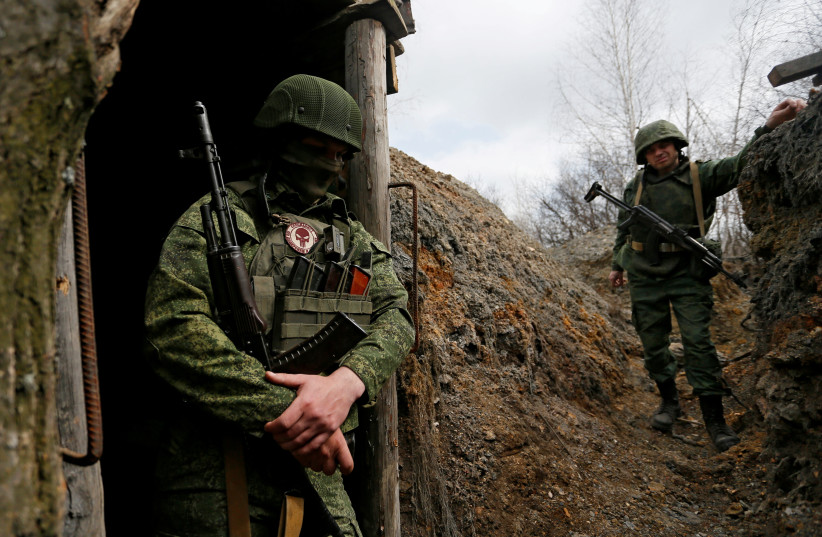Like many, I also turned to Twitter last Tuesday to understand the situation unfolding in Ukraine. The day began, as always, with a barrage of memes mocking a meeting between Russian President Vladimir Putin and his Foreign Minister Sergei Lavrov. In an official image published by the Kremlin, the two Russians sat at a great distance separated by a long, narrow table. Twitter users soon compared this meeting to that of Darth Vader and Han Solo in Star Wars, or the great distance between Citizen Kane and his wife.
Then, during the late afternoon, there was a startling update – according to Israeli news sites, thousands of Russian troops were closing in on Ukraine’s borders and a Russian invasion seemed imminent. Yet the tweets populating my feed suggested otherwise. According to one self-proclaimed intelligence expert, the Ukrainian army was poised and well equipped to meet Russian troops, if they should invade. Another expert maintained that while the Ukrainian military was ready for an invasion, its oligarchs were fleeing the country in anticipation of Russian troops.
Both tweets included testimonials, be it videos of well-armed Ukrainian soldiers or maps charting flight paths across Ukraine. Twitter thus suggested that while an invasion may be imminent, the situation was far from calamitous. This was also the sentiment expressed by a Lithuanian official tweeting that Stinger missiles, effective against Russian helicopters, had arrived in Ukraine. Yet the Lithuanian’s confidence did not exactly match some of the trending images on Twitter, such as one supposedly depicting an elderly Ukrainian grandmother named Valentina being instructed on how to use a Kalashnikov rifle.
If Ukraine’s defense hinged on Valentina’s capabilities, perhaps the country was not really prepared for a Russian invasion. Then came a tweet from the Terror Alarm site and the confident assertion – the invasion was happening. Russia had crossed the Rubicon, or at least the city of Perekop. Russian soldiers, aided by massive air support, were marching on Kyiv while meeting little to no resistance. For a moment, I imagined that Grandma Valentina had decided to steal the Lithuanian Stinger missile and head for the mountains where she would mount a guerrilla war campaign.
The sense of urgency increased as my Twitter feed was awash with TikTok videos all supposedly showing Russian troops marching into Ukraine, alongside tanks, armored vehicles and an armada of helicopters. Some videos stated that Russian soldiers were only 10 kilometers from Ukraine’s borders. Twitter videos even depicted the mobilization of Ukrainian field hospitals headed for the Russian front.
But soon thereafter, the alarm turned mute. Valentina had not fled after all. And now, even her granddaughter was joining the fight in the blasé mindset expected from a millennial. Images circulated on Twitter captured Ukrainian teens mesmerized by smartphones while cradling assault rifles and grenades. Other videos focused on Ukrainian military officers training citizens in hand-to-hand combat.
Naturally, I assumed that even Valentina’s neighbors had joined the struggle, proving a formidable match to the Russian tanks, which were now caught in a quagmire. A trending TikTok video had located a column of Russian tanks sinking in muddy terrain awaiting a rescue by large bulldozers.
AMUSED, CONFUSED and alarmed I turned to trusted online sources. Surely online news sites would be offering real-time coverage of an invasion that was either forthcoming, underway or canceled. I first turned to BBC News, the last vestige of the mighty British Empire and a bastion of integrity and objective reporting. However, all I learned was that British nationals should leave Ukraine, that the British economy grew despite the COVID-19 pandemic and that Prime Minister Boris Johnson was questioned by police about Downing Street parties during lockdown.
Angrily, I turned to CNN. I felt foolish. The Brits have long since lost their grit. What was needed was courageous reporting from the war zone, the kind of daring news coverage that turned CNN into a formidable news channel in the early 1990s. Yet even here, there was little to no mention of Ukraine. I did learn that beloved director Ivan Reitman had died, that a shooting had occurred in Kentucky and that the US closed its Embassy in Kyiv. A shame, I thought, as Valentina would lose her one chance to realize her dream of seeing Ellis Island.
There was no follow-up on CNN’s Twitter feed; were no live videos from Ukraine’s borders and no intrepid journalists marching into the fog of war. Nothing to dispel those TikTok videos of Russian troops invading Ukraine.
Finally, I turned to diplomats hoping that foreign ministries had realized that it was precisely at these moments of confusion and uncertainty that they could use Twitter to narrate events and help online publics make sense of unfolding events. The US State Department offered crucial information: Secretary of State Antony Blinken had been in Fiji, COVID-19 vaccines were being shipped abroad and love filled US diplomatic corridors as it was Valentine’s Day. The White House proved equally informative showcasing the Biden couple lovingly strolling across a white beach. The British Foreign Office did comment on Ukraine yet apparently suffered from a slight time delay commenting on events that happened in the morning.
The question “What on earth is happening in Ukraine?” remained unanswered. Not even NATO offered any analysis of reporting of events. Like most Twitter users, I remained confused and confident that a Russian invasion was either imminent, underway or over. As for Valentina – latest reports suggest that she has been deputized by Ukraine’s president and is now commander in chief of the armed forces. Like me, she had quite a day.
The writer is a digital diplomacy scholar at Ben-Gurion University of the Negev and a member of Oxford University’s Digital Diplomacy Research Group.

